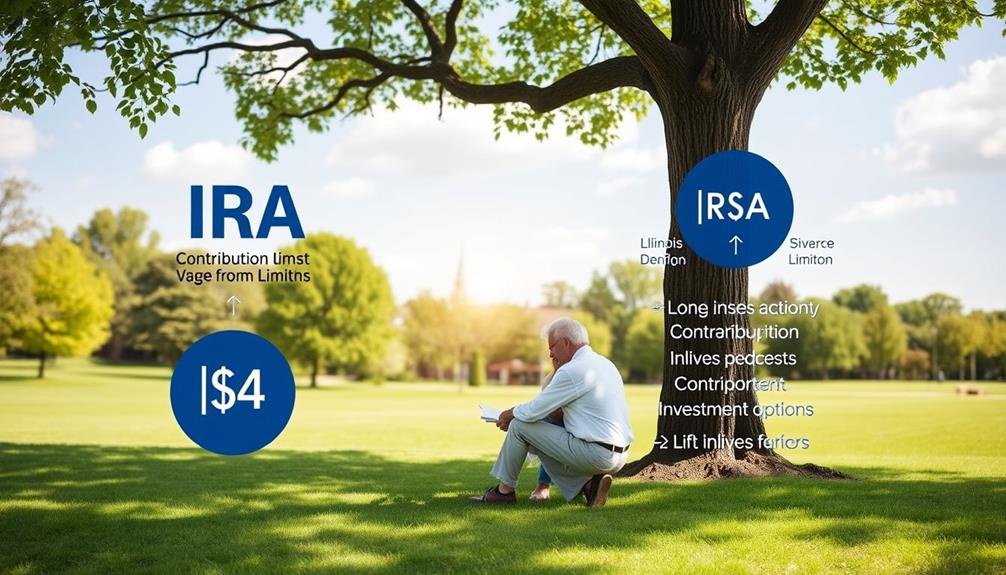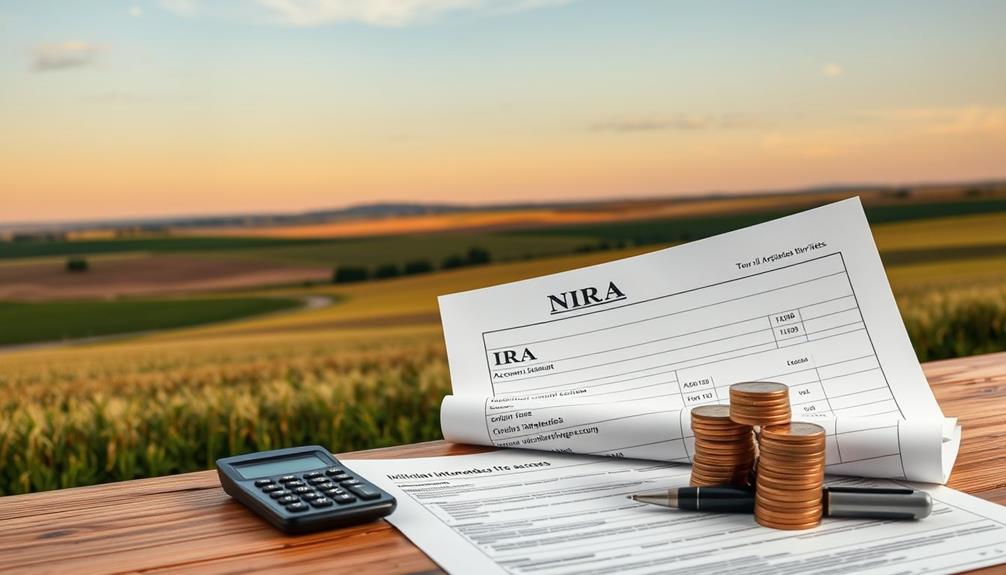When preparing for retirement in Illinois, it is crucial to incorporate IRAs with state-specific advantages such as the Illinois Secure Choice program. This initiative aims to assist private-sector workers in saving for retirement by implementing automatic payroll deductions into Roth IRAs, beginning with a default contribution of 5%. When exploring your choices, take into account the contribution limits for IRAs — $7,000 for individuals under 50 and $8,000 for those 50 and over. Familiarizing yourself with these aspects can enhance your savings. There is plenty more to discover about optimizing your retirement plan while utilizing these state benefits.
Key Takeaways
- Illinois Secure Choice provides a Roth IRA option for employees without employer-sponsored retirement plans, encouraging savings through automatic payroll deductions.
- The default contribution rate is 5%, adjustable to 10%, promoting easy integration with personal IRA contributions.
- Participants enjoy tax-free withdrawals on contributions, enhancing the appeal of combining state-specific benefits with individual retirement accounts.
- Employers are responsible for facilitating employee contributions, simplifying the process for those new to retirement planning.
- Understanding compliance deadlines and penalties helps ensure that businesses contribute effectively to employees' retirement savings through the Secure Choice program.
Overview of Illinois Secure Choice

The Illinois Secure Choice program, launched in 2018, aims to help private-sector employees save for retirement when their employers don't offer a retirement plan. This state-sponsored retirement plan is designed specifically for eligible employees at companies with at least five workers that have been operational for a minimum of two years.
If your employer falls into this category, you'll be automatically enrolled unless they already provide a qualified retirement plan. This initiative is part of a broader strategy to address the lack of retirement savings options and promote financial health among workers, reflecting the importance of creating a personal budget.
Your contributions will be deducted from your post-tax payroll, starting with a default contribution rate of 5% of your gross pay, which can increase to 10% if you choose. This program functions as a Roth IRA, allowing you to make tax-free withdrawals upon qualifying events.
Additionally, you can select from a range of low-fee investment options managed by Ascensus.
It's important to note that employers face penalties for non-compliance, beginning at $250 per eligible employee in the first year and escalating to $500 in subsequent years. This financial incentive encourages businesses to participate and provide valuable retirement savings options to their employees.
Employer Registration and Compliance

As an employer in Illinois, you need to know if your business qualifies for the Secure Choice program, especially if you have at least five employees.
The program aims to enhance retirement savings among workers and can be an essential part of diversification of retirement portfolio.
Registration deadlines vary based on your employee count, and missing them can lead to hefty penalties.
Understanding these rules is important to guarantee compliance and avoid unnecessary fines while providing retirement savings options for your team.
Employer Eligibility Criteria
To participate in Illinois' Secure Choice program, employers need to meet specific eligibility criteria. First, your business must have at least five employees and be operational for a minimum of two years.
If you currently offer or contribute to a qualified retirement plan, like a 401(k) or SEP-IRA, you're exempt from the Illinois Secure Choice requirements for the last two years. Additionally, considering options like a Gold IRA can be beneficial for those looking to expand their retirement investment strategies, as trusted precious metal IRA options are available to enhance your portfolio.
Understanding the employer eligibility criteria is essential for compliance. If you don't register and meet the program's standards, you could face non-compliance penalties of $250 per eligible employee for the first year and $500 for each subsequent year.
It's also your responsibility to facilitate employee contributions through payroll deductions, which default to 5% of compensation unless employees choose to opt out or adjust their contribution rate.
Keep in mind that registration deadlines vary based on your number of employees. Larger employers must register first, starting from November 2018 for those with 500 or more employees.
Make sure you're on top of these requirements to avoid penalties and help your employees secure their financial futures through the Secure Choice program.
Registration Deadlines Overview
Maneuvering registration deadlines for the Illinois Secure Choice program is vital for employers to guarantee compliance and avoid penalties. If you employ 500 or more employees, you should have registered by November 2018.
Employers with 100-499 employees faced a July 2019 deadline, while those with 25-99 employees needed to register by November 2019. For businesses with 16-24 employees, the deadline was November 1, 2022, and if you have 5-15 employees, mark November 1, 2023, on your calendar.
It's essential to meet these registration deadlines to secure compliance with state requirements. The Illinois Secure Choice program mandates automatic enrollment of eligible employees into a Roth IRA unless they choose to opt out or modify their contributions.
Failing to register can lead to penalties that start at $250 per eligible employee for the first year and increase to $500 in subsequent years. As you navigate retirement planning, prioritize these deadlines to avoid unnecessary financial repercussions and ensure your employees benefit from this program.
Staying informed and proactive will help you maintain compliance and support your workforce effectively.
Non-Compliance Penalties Explained
Failing to register for the Illinois Secure Choice Savings Program can lead to hefty penalties for employers. If you're not compliant with the Illinois Secure Choice Act, you could face significant fines that escalate over time. Here's what you need to know:
- Initial Penalties: For the first year of non-compliance, you'll incur a penalty of $250 per eligible employee.
- Escalating Costs: This amount jumps to $500 for each additional year, meaning a business with 25 employees could face penalties exceeding $12,500 annually.
- Exemption Options: You can avoid these penalties if you offer a qualified retirement plan, like a 401(k) or SEP-IRA, ensuring it meets the program's eligibility criteria.
Registration deadlines vary based on the size of your business, so it's essential to stay informed.
The Illinois Secure Choice Savings Board actively monitors compliance, so make sure to adhere to the deadlines to protect your business from these financial burdens.
Prioritize compliance to support your employees' retirement savings plan while avoiding unnecessary penalties.
Contribution Limits and Investment Options

When planning your retirement in Illinois, it's essential to understand the contribution limits for accounts like Roth IRAs, which stand at $7,000 for those under 50 and $8,000 for older individuals in 2024.
You'll also want to explore the investment options available through the Illinois Secure Choice program, which offers a variety of low-fee funds managed by Ascensus.
With these details in mind, you can make informed decisions that align with your retirement goals.
Annual Contribution Limits
Understanding the annual contribution limits is essential for effective retirement planning in Illinois. These limits help you maximize your retirement savings while ensuring compliance with IRS regulations.
Here are three key points to take into account:
- Roth IRA Limits: For 2024, if you're under 50, you can contribute up to $7,000 to your Roth IRA. If you're 50 or older, you can take advantage of catch-up contributions, raising your limit to $8,000.
- Income Restrictions: Be aware that the ability to contribute to a Roth IRA phases out at $161,000 for single filers and $240,000 for married couples filing jointly.
- Illinois Secure Choice: This program sets default employee contributions at 5% of gross pay, which can escalate to 10%.
You have the flexibility to adjust your contribution rates whenever you choose.
Investment Option Overview
Investment options play an essential role in shaping your retirement savings strategy in Illinois. With the Illinois Secure Choice program, you can maximize your contributions, especially if you're under 50, with a limit of $7,000, or $8,000 if you're 50 or older. Employee contributions default to 5% of your gross pay, which can escalate to 10%, allowing for a structured approach to saving.
Here's a quick overview of your investment options:
| Investment Type | Key Features |
|---|---|
| Age-Based Target-Date Funds | Designed to adjust as you approach retirement |
| Indexed Funds | Low fees, helping to increase net returns |
| Traditional IRA | Available if you don't qualify for Roth IRA |
| Secure Choice | State program for easy participation |
| Flexible Contributions | Adjust your rates anytime to fit your financial situation |
These investment options provide flexibility and cater to various financial situations, ensuring your retirement savings align with your goals. Whether you choose a Roth IRA or a Traditional IRA, you have the tools to build a solid financial future.
Roth IRA Features
Roth IRAs offer a unique advantage in retirement planning, especially for those looking to maximize their tax-free income in retirement.
With the right strategies, you can effectively enhance your savings. Here are three key features to evaluate:
- Contribution Limits: In 2024, you can contribute up to $7,000 if you're under 50, and $8,000 if you're 50 or older. Just keep in mind the income limits—$161,000 for single filers and $240,000 for married couples filing jointly.
- Tax-Free Withdrawals: Contributions to a Roth IRA are made through post-tax payroll deductions, allowing for tax-free withdrawals upon qualifying events, giving you peace of mind in retirement.
- Investment Options: Within the Illinois Secure Choice program, your investment options typically include age-based target-date funds and low-fee indexed funds.
Default employee contributions are set at 5%, but you can adjust your contribution rates or opt-out entirely.
Benefits of State-Sponsored Retirement Plans

As you plan for your future, considering state-sponsored retirement plans like the Illinois Secure Choice program can be a smart move. This program offers a straightforward way for employees without an employer-sponsored plan to save for retirement through automatic payroll deductions into Roth IRAs.
With a default contribution rate of 5% of gross pay, which can auto-escalate to 10%, the program encourages higher retirement savings among participants.
One of the key benefits is that employers aren't responsible for managing these plans or making contributions, which alleviates administrative burdens while providing valuable retirement benefits to employees.
You'll maintain control over your account, allowing you to adjust contribution rates or opt out at any time. This flexibility empowers you to tailor your retirement savings strategy according to your financial goals.
The Illinois Secure Choice program aims to boost retirement savings for approximately 1.2 million workers in the state who currently lack access to employer-sponsored retirement plans.
Challenges of Illinois Secure Choice

Steering through the Illinois Secure Choice program presents several challenges for both employers and employees. For employers with at least five employees and no existing retirement plan, managing compliance deadlines can be intimidating. Here are three key challenges you should be aware of:
- Non-compliance Penalties: If you fail to comply, you could face financial penalties starting at $250 per eligible employee in the first year, escalating to $500 in subsequent years. For a business with 25 employees, this could mean over $12,500 annually.
- Limited Employer Involvement: As an employer, you can't endorse or provide financial advice on Secure Choice options, which could create confusion among employees about their investment choices.
- Administrative Burden: While the program aims to enhance retirement savings, the responsibilities surrounding payroll deductions and employee enrollment may feel overwhelming, despite the program's design to minimize costs and efforts.
Additionally, the default contribution rate of 5% might strain lower-wage workers' budgets, especially if automatic increases push contributions to 10% without your employees' active consent.
Addressing these challenges is vital for successful retirement planning in Illinois.
Comparing IRAs and 401(k) Plans

When it comes to retirement savings, understanding the differences between IRAs and 401(k) plans is essential for effective planning. Both options have unique features that can shape your financial future.
For instance, traditional IRAs may offer tax-deductible contributions, depending on your income and existing retirement plans, while Roth IRAs allow after-tax contributions, leading to tax-free withdrawals in retirement.
In comparison, 401(k) plans typically allow you to contribute much more—up to $22,500 or $30,000 if you're 50 or older.
One notable advantage of 401(k) plans is employer matching contributions, which can greatly boost your retirement savings. However, your investment options are often limited to a selection chosen by your employer.
On the other hand, IRAs provide a broader range of investment options, including stocks, bonds, and mutual funds.
Both account types impose penalties for early withdrawals before age 59½, but the rules can differ, especially regarding hardship withdrawals and loans.
Ultimately, deciding between IRAs and 401(k) plans involves considering your unique financial situation and future retirement goals, especially within the framework of Illinois Secure Choice.
Frequently Asked Questions
What Is the New Retirement Law in Illinois?
Illinois' new retirement law, the Secure Choice Act, requires employers with five or more employees to enroll them in a state-sponsored savings program if they don't offer a qualified plan, ensuring employees can save for retirement.
What Is the Rule of 85 in Illinois?
The Rule of 85 in Illinois lets you retire with full benefits when your age and years of service total 85. You need to be at least 55 and have 30 years of service credit.
What Type of Retirement Plan Is Illinois Secure Choice?
Imagine planting a seed for your future; Illinois Secure Choice is a Roth IRA that allows you to nurture your savings with post-tax contributions. It automatically enrolls you, making retirement planning effortless and effective.
What Is the Difference Between Tier 1 and Tier 2 Retirement in Illinois?
In Illinois, Tier 1 offers a more generous defined benefit plan with guaranteed annual increases, while Tier 2 provides lower monthly payouts and adjusts benefits based on inflation. You'll want to understand these differences clearly.
Conclusion
As you navigate the winding road of retirement planning in Illinois, remember that integrating IRAs with state-specific benefits can be your compass. Illinois Secure Choice offers a sturdy bridge over the turbulent waters of financial uncertainty, guiding you toward a brighter future. By understanding the nuances of employer compliance, contribution limits, and investment options, you can harness the power of these tools, ensuring your golden years shine as brightly as the sun on a clear summer day.









